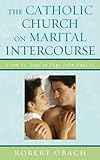The Catholic Church on marital intercourse : from St. Paul to Pope John Paul II / Robert Obach.
Material type: TextPublication details: Lanham, MD : Lexington Books, c2009.Description: 1 online resource (x, 226 p.)Content type:
TextPublication details: Lanham, MD : Lexington Books, c2009.Description: 1 online resource (x, 226 p.)Content type: - 9780739130896
- 1282493515
- 9781282493513
- 0739130897
- 9786612493515
- 6612493518
- Catholic Church -- Doctrines -- History
- Église catholique -- Doctrines -- Histoire
- Catholic Church
- Sex -- Religious aspects -- Catholic Church -- History of doctrines
- Marriage -- Religious aspects -- Catholic Church -- History of doctrines
- Sexualité -- Aspect religieux -- Église catholique -- Histoire des doctrines
- Mariage -- Aspect religieux -- Église catholique -- Histoire des doctrines
- RELIGION -- Christian Theology -- Ethics
- Marriage -- Religious aspects -- Catholic Church -- History of doctrines
- Sex -- Religious aspects -- Catholic Church -- History of doctrines
- Theology, Doctrinal
- 241/.66 22
- BX1795.S48
- online - EBSCO
| Item type | Current library | Call number | URL | Status | Notes | Barcode | |
|---|---|---|---|---|---|---|---|
 eBook
eBook
|
Biblioteca "Angelicum" Pont. Univ. S.Tommaso d'Aquino Nuvola online | online - EBSCO (Browse shelf(Opens below)) | Online access | Not for loan (Accesso limitato) | Accesso per gli utenti autorizzati / Access for authorized users | (ebsco)258480 |
Includes bibliographical references and index.
Description based on print version record and CIP data provided by publisher; resource not viewed.
The Catholic Church on Marital Intercourse traces the development of the Church's theology of marital sexuality from New Testament times to the present day. The early ecclesial leaders promoted a theology of sexuality based on Stoicism's biological perception that sexual activity was solely for the purpose of reproduction. Only in the early twentieth century did a few theologians begin to move beyond discussing 'the purposes of marital intercourse' to discussing the meaning that the marital act might have for the spouses themselves. With the Second Vatican Council (1962-1965), a new and positive view of marital sexuality emerged recognizing the Pauline view that the couple's marital acts express their love for each other along the lines of Christ's love for his church (Ephesians 5). In sum, The Catholic Church on Marital Intercourse treats the way in which the Catholic Church has moved away from an attitude of conditional acceptance of marital intercourse on the basis of its utility to recognition that the dynamics of sexual union are both good and holy, not only because that is the way children are conceived, but also because the marital act enhances the love of husband and wife for each other.
Preface; Acknowledgments; Introduction; Chapter 01. Biblical Approaches to Marital Sexuality; Chapter 02. St. Paul's Unwitting Contributions to the Church's Negative Thinking on Marital Intercourse; Chapter 03. Early Church Leaders Defend Marriage Against Gnostic Attacks; Chapter 04. Augustine: The Man Who Carved in Stone the Church's Conditional Acceptance of Marital Intercourse; Chapter 05. Monks, Theologians, Bishops, and Popes Disparage Marital Intercourse; Chapter 06. The Law of Clerical Celibacy Embodies the Bias Against Marital Intimacy
Chapter 07. Canon Law Sees Nothing Spiritual in Marital IntimacyChapter 08. Marriage Recognized as a Sacrament; Chapter 09. St. Thomas Aquinas: Modifications and Qualifications; Chapter 10. Some Attempts to See Other Values in Marital Intercourse; Chapter 11. The Council of Trent: Motives for Marrying and Motives for Abstaining from Marital Intercourse; Chapter 12. A New Development: Spousal "Affection" Related to "Love"; Chapter 13. Confessing Sins Related to Sexual Activity; Chapter 14. Pope, Bishops, Theologians, and Canon Law Stress Procreation as the Primary Purpose of Marriage
Chapter 15. A New Vision: Love Related to Marital IntercourseChapter 16. The Teaching of Pope Pius XI: Procreation or Abstinence; Chapter 17. A Rejected Perspective: Bodily Union as the "Direct Purpose" of Marital Intercourse; Chapter 18. The Break with St. Augustine: Pope Pius XII Accepts the Rhythm Method; Chapter 19. The Effects of Papal Teaching: Frustration and Tears; Chapter 20. The Second Vatican Council (1962-1965) Recognizes the Value of Marital Love; Chapter 21. The Postconciliar Work of the "Birth Control Commission" and Its Culmination in Humanae Vitae
Chapter 22. Pope John Paul II: Old Assertions and New PerceptionsChapter 23. Conscience and Fidelity to Church Teaching; Epilogue; Index
English.


